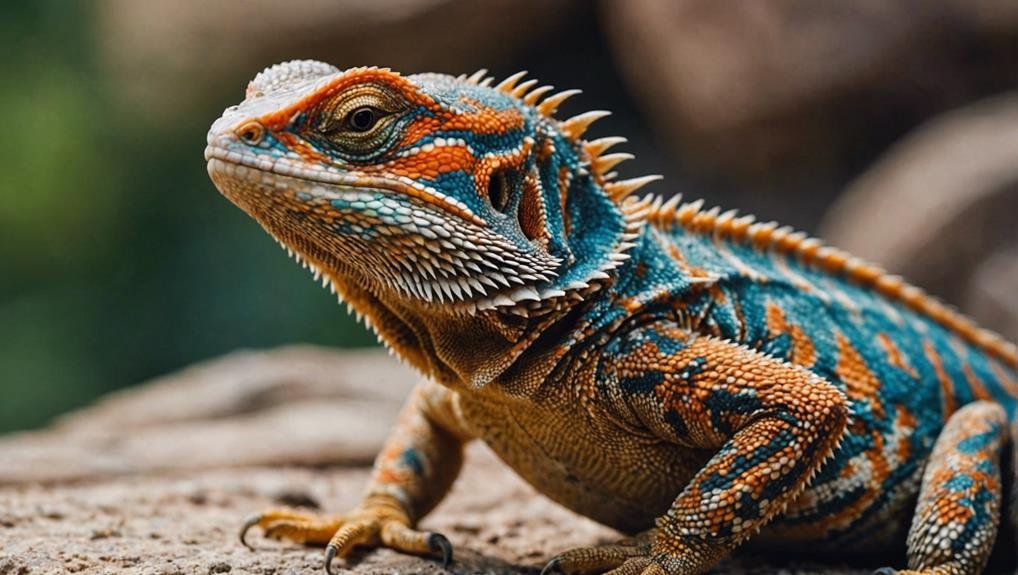When your bearded dragon starts shedding, you might notice changes in behavior and appearance that indicate it’s time for this natural process. Shedding is essential for their growth and health, but it can sometimes pose challenges if not properly managed. Do you know how often your dragon should shed and what signs to look for? Understanding these aspects can help you provide the best care. You’ll guarantee their well-being and comfort by learning how to assist your pet during shedding and recognizing potential issues. Let’s explore how to make this process smoother and address common concerns.
Key Takeaways
- Bearded dragons shed to accommodate growth and maintain healthy skin.
- Shedding frequency varies with age; young dragons shed more often than adults.
- Signs of shedding include lethargy, loss of appetite, and dull skin.
- Warm baths and rough surfaces can aid the shedding process.
- Proper hydration and a balanced diet are essential for smooth shedding.
Why Do Bearded Dragons Shed
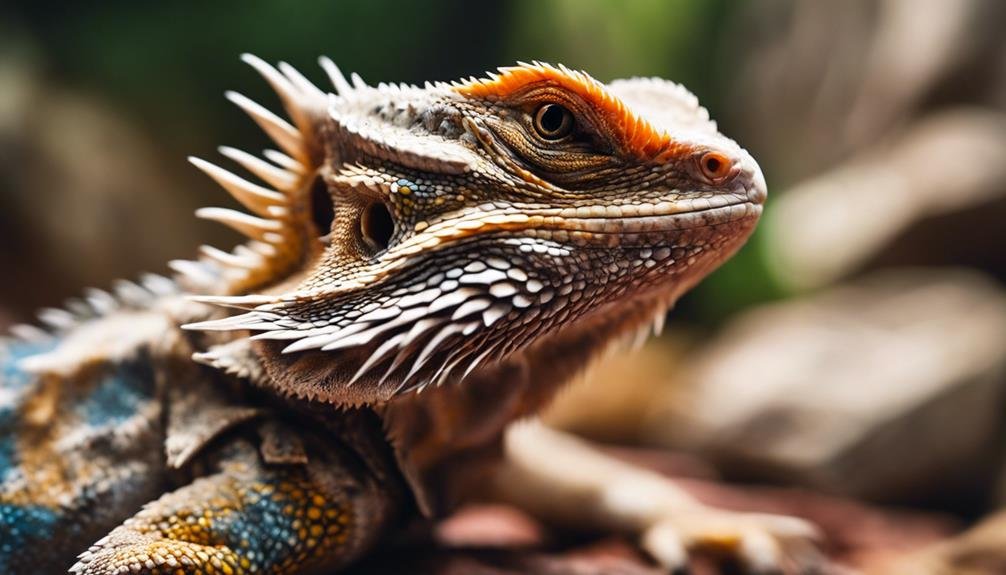

Bearded dragons shed their keratinized scales because their inelastic skin can’t grow with them. This shedding process, the ecdysis process, is important for their healthy growth. Since a bearded dragon’s skin doesn’t stretch, they must shed to accommodate their increasing size. You’ll notice this skin shedding as a sign that your pet is growing properly.
The shedding process isn’t just about growth, though. It also helps bearded dragons replace damaged or injured skin. By shedding, they can maintain a protective layer that shields them from infections and other potential harm. When your dragon sheds, it gets a fresh, healthy layer of skin, contributing to its overall well-being.
Additionally, the shedding process aids in absorbing calcium. This is crucial for their bone development and overall health. When new skin forms, it helps in better calcium absorption, ensuring your dragon stays strong and healthy. Shedding is a natural and necessary part of a bearded dragon’s life. It allows them to grow, stay healthy, and keep their skin in top condition. So, when you see your dragon shedding, know it’s a sign of a thriving pet.
Shedding Frequency
Young dragons shed their skin every 1-6 weeks, with the frequency decreasing as they age. Shedding is common for baby bearded dragons due to their rapid growth. Babies can shed as often as weekly, guaranteeing their skin accommodates their expanding size. As bearded dragons mature, their shedding frequency decreases considerably. Adults generally shed once or twice a year.
Shedding patterns can vary, affecting different body areas like the tail, limbs, and body at other times. This segmented shedding is normal and aligns with the dragon’s growth and health. Monitoring these patterns helps you understand your bearded dragon’s development. It could indicate health issues if you notice irregular shedding or extended periods without shedding.
The shedding process can last from a few days to two weeks, influenced by the dragon’s age and overall well-being. Healthy shedding is a sign of proper growth and skin maintenance. Conversely, irregular shedding might signal underlying health concerns.
Regularly observing your bearded dragon’s shedding frequency and patterns allows you to make sure they’re growing properly and maintaining good health.
Signs of Shedding
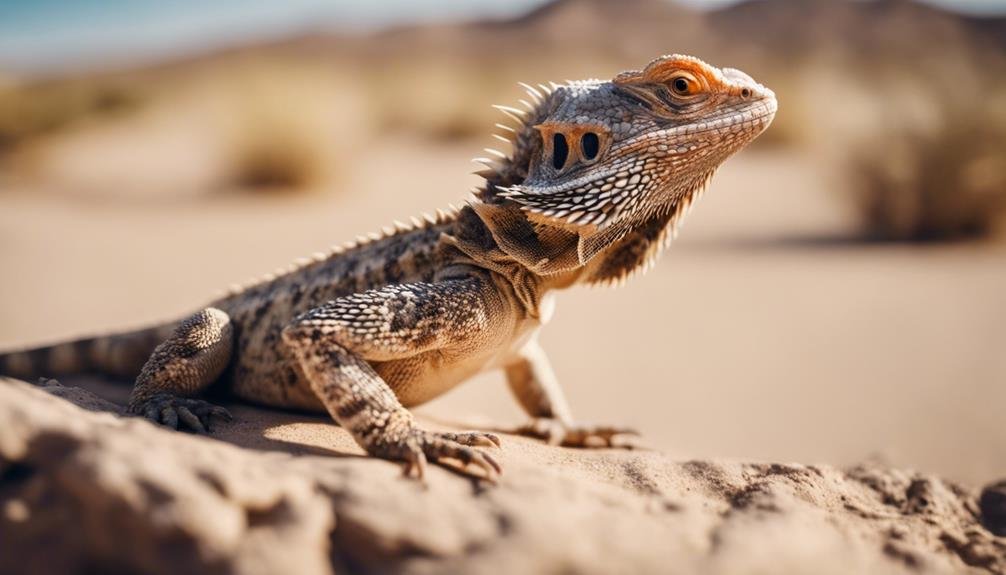

When your bearded dragon is about to shed, you’ll notice several telltale signs like lethargy, loss of appetite, and increased scratching behavior. These shedding indicators are your first clue that your pet is entering the shedding process. Bearded dragons often show changes in their skin, such as flaking off in small patches and a faded or dull color. You might also observe milky or dull scales, clear signs that shedding is imminent.
During the shedding process, your bearded dragon may exhibit increased irritability and avoidance of handling. Shedding can be itchy and uncomfortable, leading to skin irritation. It’s common to see your bearded dragon scratching against rough surfaces to help loosen the shedding skin.
Another shedding behavior to watch for is the appearance of a black beard, which signals stress and discomfort.
Understanding these shedding indicators can help you better care for your bearded dragon. By monitoring changes in behavior and skin condition, you can ensure your pet is comfortable and healthy throughout the shedding process. Recognizing these signs early allows you to provide the necessary support and adjustments in their environment.
Assisting the Shedding Process
To aid your bearded dragon during shedding, provide rough materials in the enclosure for them to rub against. Rocks, branches, or textured surfaces can help loosen and remove the shedding skin. This important behavior is vital in facilitating the shedding process.
Warm baths are another effective method. Soak your bearded dragon in lukewarm water for about 15-20 minutes. The moisture and warmth can help soften the old skin, making it easier to shed. Make sure the water is shallow enough for them to stand comfortably.
Using a soft toothbrush can also be beneficial. Gently brush the areas where the skin is stubbornly clinging. This can assist in removing the shed without damaging the new skin underneath.
Remember to offer a calcium supplement during the shedding period. Calcium is essential for healthy skin regeneration and overall health. Sprinkle the supplement on their food to ensure they’re getting enough nutrients.
Most importantly, avoid pulling or picking at the shedding skin. This can cause injury or damage to the new skin. Let the shedding process occur naturally, intervening only to provide gentle assistance and support. Your bearded dragon will appreciate the extra care.
Common Shedding Issues
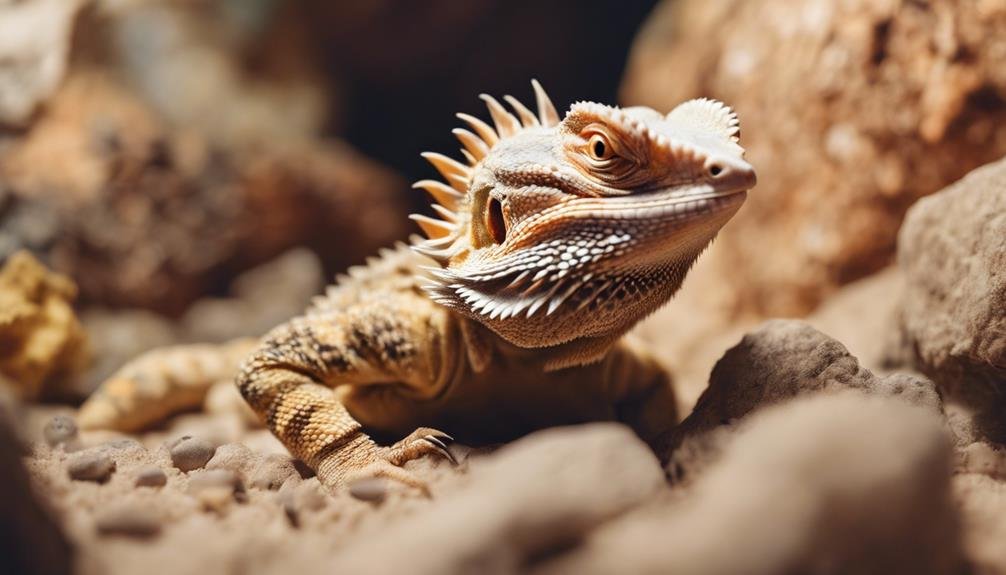

During shedding, bearded dragons face several common issues requiring attentive care. One major concern is retained shed, where old skin doesn’t fully come off. This can constrict circulation, leading to serious health problems.
Dehydration can also hinder the shedding process, making their skin dry and flaky. Proper hydration is essential for smooth shedding. An improper diet lacking essential nutrients can negatively affect the quality of your bearded dragon’s shedding. A balanced diet supports healthy skin and shedding cycles.
Skin infections are another significant issue. If the environment isn’t clean, bacteria can invade the skin, causing infections that complicate shedding. To avoid these problems, regular monitoring and proper care are vital. Keep a close eye on your bearded dragon during the shedding process and address any issues promptly.
Here are some common shedding issues to watch for:
- Retained shed: Old skin that doesn’t fully come off.
- Dehydration: Dry, flaky skin hindering the shedding process.
- Improper diet: Lack of essential nutrients affecting shedding quality.
- Skin infections: Bacterial invasions due to an unclean environment.
Importance of Hydration
Ensuring your bearded dragon stays hydrated is essential for a smooth and healthy shedding process. Hydration plays a pivotal role in bearded dragon shedding by helping to soften skin, making it easier for your pet to shed its old skin.
One effective way to provide hydration during shedding is through regular baths. Bathing your bearded dragon delivers essential hydration and relieves discomfort and itching that often accompany the shedding process.
Adequate hydration is necessary for preventing dry skin, which can lead to complications and delays in shedding. Proper hydration ensures that your bearded dragon’s skin remains supple and less prone to cracking or peeling. Hydration through baths is particularly beneficial because it allows moisture to penetrate the skin directly, aiding the overall shedding process.
In addition to baths, always ensure your bearded dragon has access to fresh water. This helps maintain hydration levels from the inside out, contributing to overall health and well-being.
Maintaining Proper Diet
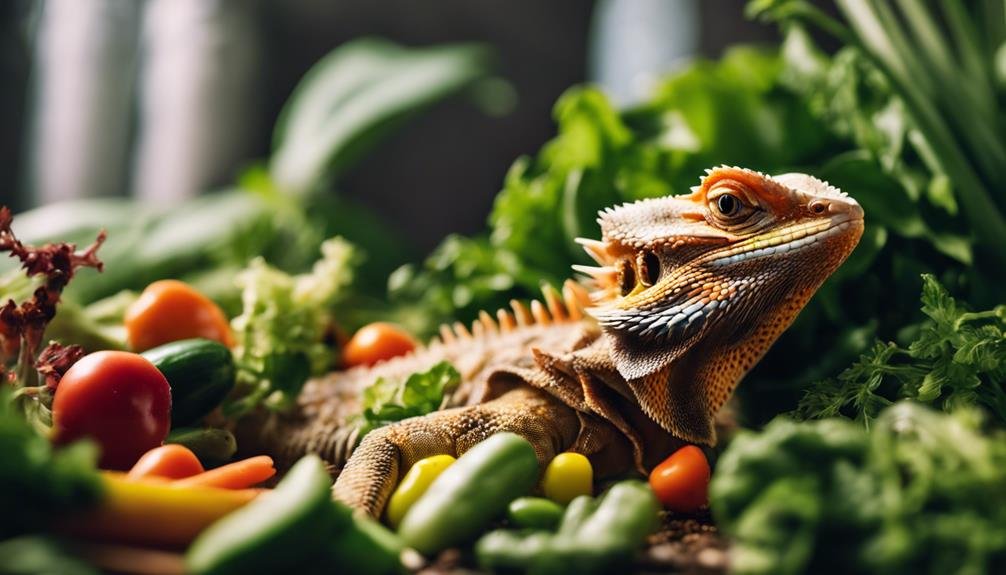

A well-balanced diet rich in essential nutrients like calcium and vitamins is important for a healthy shedding process in your bearded dragon. Ensuring your pet gets the right mix of foods can significantly affect how smoothly it sheds skin.
A proper diet supports healthy shedding and boosts overall skin health.
To maintain a balanced diet for your bearded dragon, consider the following:
- Calcium and Vitamin D3 Supplements are essential for bone and skin health and help your dragon shed efficiently.
- Adequate Hydration: Fresh vegetables and occasional fruits provide the necessary moisture to aid the shedding process.
- Protein Sources: Insects and commercially prepared feed ensure your dragon gets enough protein for robust skin health.
- Avoid Fatty or Sugary Foods: These can negatively impact the shedding process and overall health.
Conclusion
Understanding and supporting your bearded dragon’s shedding process will safeguard its health and well-being. Watch for shedding signs, offer rough surfaces and warm baths, and maintain a nutrient-rich diet.
Proper hydration and monitoring shedding patterns are vital, too. With these steps, you’ll help your dragon shed comfortably and stay happy.
Remember, a well-cared-for bearded dragon is a thriving one!
Related Article:
https://thereptileguide.com/do-bearded-dragons-like-water-swimming-bathing/
https://thereptileguide.com/corn-snake-lifespan/

